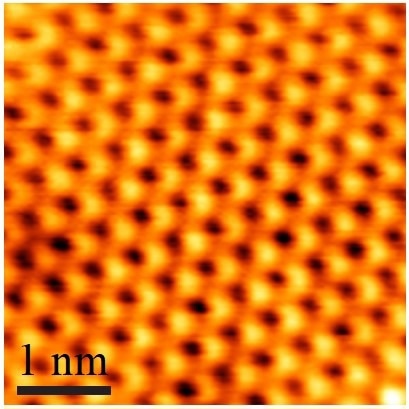Germanene, a two-dimensional material made up of germanium atoms, has been demonstrated to function as a topological insulator by researchers from the University of Twente.
 Scanning tunnelling microscopy topography of the honeycomb lattice of germanene. Image Credit: University of Twente
Scanning tunnelling microscopy topography of the honeycomb lattice of germanene. Image Credit: University of Twente
It is the first single-element, 2D topological insulator identified. Like transistors, it also has the unusual ability to flip between the “on” and “off” states.
Topological insulators are materials with the unusual ability to carry electricity along their edges while isolating it within. Electrical current can pass along the conductive edges without wasting any energy.
At the moment, electronic devices lose a lot of energy in the form of heat, because defects in the material increase the resistance. As a result, your mobile phone can get uncomfortably hot.
Pantelis Bampoulis, Researcher, University of Twente
In contrast to regular materials, where scattering at defects is permitted, the unique topological protection mechanism prevents electrons from scattering at defects at the borders of 2D topological insulators.
As a result, in 2D topological insulators, electrical current moves without wasting energy. They are, therefore, more energy-efficient than the materials used in modern electronics.
Creating Germanene
One such 2D topological insulator is germanene.
Bampoulis further added, “Current topological insulators consist of complex structures from different types of elements. Germanene is unique in that it’s made from just a single element.”
The scientists combined platinum and germanium in a melting process to produce this fascinating material. A thin layer of germanium atoms formed a honeycomb lattice on top of the germanium-platinum alloy when the combination cooled. Germanene is the name for this 2D layer of atoms.
Topological Transistors
The researchers also found that by applying an electric field, the material’s conducting qualities could be turned “off.” This characteristic is exclusive to topological insulators.
“The possibility to switch between ‘on’ and ‘off’ states add an exciting application case for germanene,” Bampoulis added.
It makes topological field-effect transistor design possible. In electronic devices, these transistors can take the place of conventional transistors. causing devices to stop heating up.
More Information
In the Physics of Interfaces and Nanomaterials Group (PIN; Faculty of S&T / MESA+), Dr. Pantelis Bampoulis holds the position of Assistant Professor. He is a featured scientist at UT as well.
He recently shared his research in a study titled “Quantum Spin Hall States and Topological Phase Transition in Germanene” in the scientific journal Physical Reviews Letters alongside PhD students Carolien Castenmiller and Dennis Klaassen. The research has been highlighted in the APS Physics magazine, and one of the images from the article was used to design the journal’s cover.
Journal Reference:
Bampoulis, P., et al. (2023) Quantum Spin Hall States and Topological Phase Transition in Germanene. Physical Reviews Letters. doi:10.1103/PhysRevLett.130.196401.